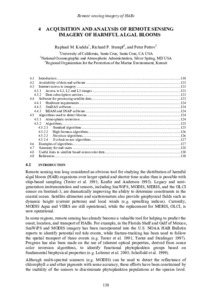Acquisition and analysis of remote sensing imagery of harmful algal blooms.

View/
Average rating
votes
Date
2017Author
Kudela, Raphael M.
Stumpf, Richard P.
Petrov, Peter
Status
Published
Metadata
Show full item recordAbstract
Remote sensing was long considered an obvious tool for studying the distribution of harmful
algal bloom (HAB) organisms over larger spatial and shorter time scales than is possible with
ship-based sampling (Tester et al. 1991; Keafer and Anderson 1993). Legacy and nextgeneration
instrumentation and sensors, including SeaWiFS, MODIS, MERIS, and the OLCI
sensor on Sentinel-3, are dramatically improving the ability to determine constituents in the
coastal ocean. Satellite altimeters and scatterometers also provide geophysical fields such as dynamic height (current patterns) and local winds (e.g. upwelling indices). Currently,
MODIS Aqua and VIIRS are still operational, while the replacement for MERIS, OLCI, is
now operational.
In some regions, remote sensing has already become a valuable tool for helping to predict the
onset, location, and transport of HABs. For example, in the Florida Shelf and Gulf of Mexico,
SeaWiFS and MODIS imagery has been incorporated into the U.S. NOAA H.....
Title of Report
Harmful Algal Blooms (HABs) and Desalination: a Guide to Impacts, Monitoring and Management.Editor(s) of Report
Anderson, D.M.Boerlage, S.F.E.
Dixon, M.B.
Page Range
pp.119-132Publisher
Intergovernmental Oceanographic Commission of UNESCOParis, France
Series;Nr
Intergovernmental Oceanographic Commission Manuals and Guides;78Document Language
enSustainable Development Goals (SDG)
14.1Essential Ocean Variables (EOV)
Phytoplankton biomass and diversityOcean colour
Best Practice Type
ManualCitation
Kudela, R.M.; Stumpf, R.P. and Petrov, P. (2017) Acquisition and analysis of remote sensing imagery of harmful algal blooms. In: Harmful Algal Blooms (HABs) and Desalination: A Guide to Impacts, Monitoring and Management. (eds. Anderson D. M.; Boerlage, S. F. E. and Dixon, M.B.). Paris, France, Intergovernmental Oceanographic Commission of UNESCO, pp. 119-132. (IOC Manuals and Guides No. 78). DOI: http://dx.doi.org/10.25607/OBP-207Collections
 Repository of community practices in Ocean Research, Applications and Data/Information Management
Repository of community practices in Ocean Research, Applications and Data/Information Management